

Floating homes: a solution to flooding, crowded cities and unaffordable housing. It’s a timber-clad house with open-plan living, pale floorboards and large windows giving views across Chichester canal.

This building designed by London-based Baca Architects has a unique feature – it floats. Completed this month, the amphibious house was developed as a prototype by Baca and Floating Homes, a manufacturer specialising in flood-resilient housing, in response to a competition launched last year to find a solution to London’s housing crisis. The house is intended to be practical, affordable (a two-bed unit will sell for £200,000) and equipped to deal with floods, by rising with the water levels. 80s streetwear label RAP is back – and it's just what Brexit Britain needs. Talking to Hassan Hajjaj is a lesson in how style and culture often come full circle.

Hajjaj, who is sometimes called Morocco’s Andy Warhol, was a key member of London’s first wave of street labels in the 80s, the kind that Palace and Aries follow on from now. He arrived in London aged 14 in the late 70s and set up RAP, or Real Artistic People – both a label and a shop – in 1984 when he was 21. Part of a community of twentysomethings from Africa and the Caribbean, he was keen to make something bespoke for them.
“I met people who had similar journeys, we were all from different cultures but made a village in London,” he says. “There wasn’t fashion for us, we couldn’t get into the clubs, we couldn’t find the food we wanted to eat. Could reinvention solve our shopping addiction? Image copyright EpicStockMedia, Thinkstock Swedish retail giant H&M seems an unlikely poster child for ecological living.
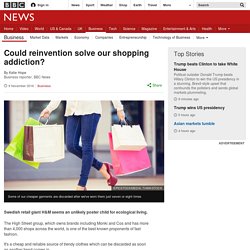
The High Street group, which owns brands including Monki and Cos and has more than 4,000 shops across the world, is one of the best known proponents of fast fashion. It's a cheap and reliable source of trendy clothes which can be discarded as soon as another trend comes in. Yet it has pledged to become "100% circular", ultimately using only recycled or other sustainable materials to make its clothes. Fashions Come And Go But If We Shop Sustainably, It Can Last A Lot Longer. The rise of brief trends over classic style and shoddy workmanship at cheap prices in the fashion industry is damaging both our planet and its people.
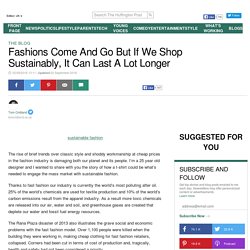
I’m a 25 year old designer and I wanted to share with you the story of how a t-shirt could be what’s needed to engage the mass market with sustainable fashion. Thanks to fast fashion our industry is currently the world’s most polluting after oil. 25% of the world’s chemicals are used for textile production and 10% of the world’s carbon emissions result from the apparel industry.
Industry Voices: Can Sustainability Be Sexy? Edward A.
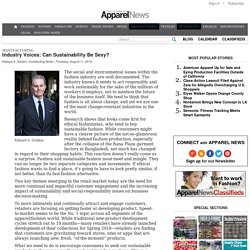
Gribbin, Contributing Writer | Thursday, August 11, 2016 The social and environmental issues within the fashion industry are well documented. A Nobel Prize for Sustainable Fashion. Before we finish eating breakfast each morning, we have already depended on more than half of the world.
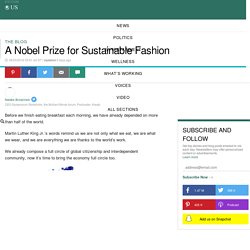
Martin Luther King Jr.’s words remind us we are not only what we eat, we are what we wear, and we are everything we are thanks to the world’s work. We already compose a full circle of global citizenship and interdependent community, now it’s time to bring the economy full circle too. As the second dirtiest industry in the world after oil, the fashion sector is the key to advancing sustainability globally. Fashion needs to take bold action to “close the loop” from “cradle to grave”, from production in the labs and factory floors to the personal production on our selves in the way we wear, use and re-use our garments, in order to slow down the degradation of our environment.
H&M Foundation Offers €1m Grant For Ideas To Make Fashion Industry More Sustainable. Sustainable Growth in the Fashion Industry. Sustainability encompasses three main areas: environmental, social and economic.
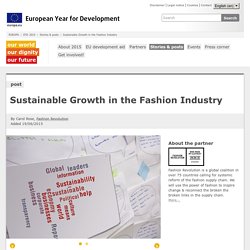
Over the last decade sustainability and sustainable growth has become one of the most prominent and important topics in our society. Even calling it a topic, would somewhat marginalise something that many would refer to as a global issue which is often overlooked usually due to monetary reasons. Sustainability across all avenues, from the fashion industry to the boardroom has been at the forefront of our endeavours to create a more ethical and environmentally advanced society. How can the fashion industry become more sustainable? Can tech give the fashion industry a sustainability makeover? - live chat. Technology is revolutionising the way we use and relate to clothes.
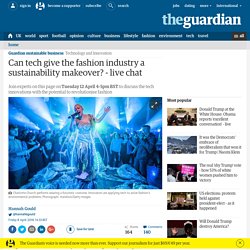
Last year, Google and Levi’s announced they were partnering on Project Jacquard to develop a fabric that can send commands to your smartphone via gestures like tapping or swiping. Ralph Lauren already offers a t shirt for a cool $295 (£210) that sends workout data to an iPhone, and Lady Gaga has brought 3D printing to the red carpet. Sustainability in the Fashion Industry - Supply Chains Effect on the Environment. As one of the biggest players in the global economy, the fashion industry has a responsibility to help protect the environment.

We’re commemorating this Earth Week by asking some tough questions about our impact on the planet and what we can do about it. We’ll also be profiling people and companies who are instigating change. Sustainability.